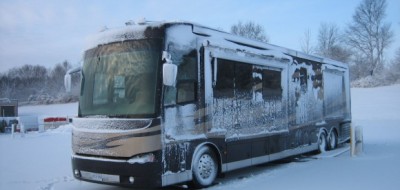Winter’s bitter winds can freeze RV door locks, windows, and doors. It’s important to know what to do if your RV doors or windows freeze and how to prevent this from happening. Use these quick and easy tips to combat the ice.
Frozen Door Locks: Prevention
Nothing can be more frustrating than finding your RV door locks frozen. One way to prevent frozen locks is to dip your key into Petroleum jelly or Vaseline, put it into the lock, and turn the key back and forth a few times. Repeat this to make sure the Vaseline is well-distributed onto the parts of the lock.
Frozen Door Locks: Solutions
- Petroleum jelly or Vaseline. Dip the key into the Vaseline, then insert it into the lock. Once in the lock, try to wiggle the key. Do not force the key to turn; this could result in breaking the key off in the lock.
- De-icer. If you find the lock already frozen, spay de-icer into the lock.
- Heat the key. Hold the key with an oven mitt or gloves with the toothed tip over a lighter or match, then insert it in the lock. The heated key inserted into the lock should melt the ice. If the key is made of only metal, you can heat the key while it is in the lock. Do not try this with keys that have plastic at the top.
- Hair dryer. Warm the lock with a hairdryer or your own breath. A cardboard tube placed over the frozen lock will help direct the warm air. Keep trying for several minutes, especially if you do not have a tube or if conditions are windy.
- Lock Lubricant. Experts tend to have differing opinions about lubricant choices, but some options are recommended more often than others. Use only one of the following options per lock, since a mix could easily gum things up. Options include graphite lubricant, Teflon-based lubricant, WD-40, and rubbing alcohol. Since there’s little consensus, use as a last resort.
Frozen Windows
The simplest solution to frozen windows is to wait until the RV interior warms up. The ice should then melt shortly.
If your RV is equipped with power windows, do not keep pushing the button. If you force the window down, you can damage the motor, and this could be expensive to repair.
Frozen Doors: Prevention
To help prevent your door from freezing shut completely, clean the doorframe and rubber seals with soapy water and thoroughly dry. This should remove road debris that can build up over time. Water can collect around the dirt and freeze the door shut once the temperatures drop.
Apply a rubber conditioner or rubber care product over the rubber seals with a clean cloth. Use 303 Protectant or other non-petroleum based product. This will repel water, reducing the amount that enters the seal and freezes.
Frozen Doors: Solutions
Do not try to force a frozen door open. This can damage the rubber seal around the door.
While wearing gloves, hit the ice with the palms of your hands, and remove the ice as it breaks. If this method does not work, you can use a hair dryer to melt the ice. Be aware that excessive heat will damage the exterior paint.





Rick Hjelm
My local locksmith gave me some Balastol lock lube to prevent freeze up during the winter. Regular maintenance using this product has given me 100% satisfaction.